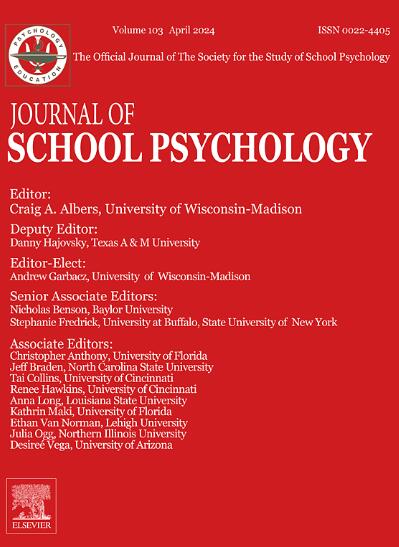Validity evidence of the Social, Academic, and Emotional Behavior Risk Screener - Teacher Rating Scale: A systematic review & quantitative synthesis
IF 4.1
1区 心理学
Q1 PSYCHOLOGY, SOCIAL
引用次数: 0
Abstract
Early identification of student social, emotional, and behavioral (SEB) concerns is vital to prevent and ameliorate future difficulties. Yet, assessment practices rely on sound validity arguments to accurately identify students who may benefit from support. As the strength of a validity argument relies on the extent of validity evidence, the synthesis of evidence may facilitate appropriate use and interpretation. Therefore, this systematic review synthesized peer-reviewed empirical studies and unpublished dissertations and theses of the Social, Academic, and Emotional Behavior Risk Screener - Teacher Rating Scale (SAEBRS-TRS) conducted in educational settings. Studies were included if they assessed the validity of the revised version of the SAEBRS-TRS. Data were extracted and coded for sample characteristics, procedural characteristics, evidence of validity, and quality appraisal. Results of the systematic search identified 29 studies meeting inclusion criteria, consisting of 65,317 students across K-12 grade levels. Overall, evidence of validity for SAEBRS-TRS scores was promising yet limited in several respects. Findings highlight limitations in the existing literature concerning the diversity of samples, a lack of studies examining measurement bias, the relative weakness of the Emotional Behavior subscale, and the need for further exploration of the factor structure for the revised version of the measure. Future research is critical to gain a complete understanding of this measure.
社会、学业和情绪行为风险筛查--教师评分量表的有效性证据:系统回顾与定量综合
早期识别学生的社会、情感和行为(SEB)问题对于预防和改善未来的困难至关重要。然而,评估实践依赖于合理的有效性论证来准确地识别可能受益于支持的学生。由于有效性论证的强度取决于有效性证据的程度,证据的综合可能有助于适当的使用和解释。因此,本系统综述综合了在教育环境中进行的社会、学术和情感行为风险筛选-教师评定量表(SAEBRS-TRS)的同行评议的实证研究和未发表的论文和论文。如果研究评估了SAEBRS-TRS修订版的有效性,则纳入研究。提取数据并对样本特征、程序特征、有效性证据和质量评价进行编码。系统检索的结果确定了29项符合纳入标准的研究,包括65,317名K-12年级的学生。总体而言,SAEBRS-TRS评分的有效性证据是有希望的,但在几个方面受到限制。研究结果强调了现有文献在样本多样性、测量偏倚研究的缺乏、情绪行为子量表的相对薄弱以及需要进一步探索修订版本的因素结构等方面的局限性。未来的研究对于全面了解这一措施至关重要。
本文章由计算机程序翻译,如有差异,请以英文原文为准。
求助全文
约1分钟内获得全文
求助全文
来源期刊

Journal of School Psychology
PSYCHOLOGY, EDUCATIONAL-
CiteScore
6.70
自引率
8.00%
发文量
71
期刊介绍:
The Journal of School Psychology publishes original empirical articles and critical reviews of the literature on research and practices relevant to psychological and behavioral processes in school settings. JSP presents research on intervention mechanisms and approaches; schooling effects on the development of social, cognitive, mental-health, and achievement-related outcomes; assessment; and consultation. Submissions from a variety of disciplines are encouraged. All manuscripts are read by the Editor and one or more editorial consultants with the intent of providing appropriate and constructive written reviews.
 求助内容:
求助内容: 应助结果提醒方式:
应助结果提醒方式:


